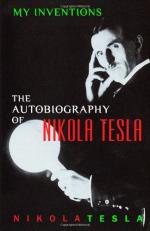|
This section contains 397 words (approx. 2 pages at 300 words per page) |
Encyclopedia of World Biography on Nikola Tesla
The Croatian-American inventor and electrical engineer Nikola Tesla (1856-1943) invented the induction motor and the transformer known as the Tesla coil and discovered the rotating magnetic field principle.
Nikola Tesla was born in Smiljan, Croatia on July 9, 1856. He attended the Polytechnic School at Graz for four years and spent a year at the University of Prague (1879-1880). His first employment was in a government telegraph engineering office in Budapest, where he made his first invention, a telephone repeater, and conceived the idea of a rotating magnetic field. He subsequently worked in Paris and Strasbourg.
In 1884 Tesla went to the United States. He was associated briefly with Thomas Edison in New Jersey, where he designed new dynamos, but the two had a salary misunderstanding and Tesla withdrew. After a difficult period, during which Tesla invented but lost his rights to an arc-lighting system, he established his own laboratory in New York City in 1887.
A controversy between alternating-current and direct-current advocates raged in the 1880s and 1890s, featuring Tesla and Edison as leaders in the rival camps. The advantages of the polyphase alternating-current system, as developed by Tesla, soon became apparent, however, particularly for long-distance power transmission. Assisted by George Westinghouse, an early convert to alternating current and Tesla's employer for a year, the system was adopted in the early 1890s for both a major power project (Niagara Falls) and a major lighting project (the Chicago World's Columbian Exposition).
Brilliant and eccentric, Tesla was then at the peak of his inventive powers. He produced in rapid succession the induction motor (utilizing his rotating magnetic field principle) and other electrical motors, new forms of generators and transformers, and a system for alternating-current power transmission; later he invented the Tesla coil and made basic discoveries concerning wireless communication. Tesla also invented fluorescent lights and a new type of steam turbine, and he became increasingly intrigued with the wireless transmission of power.
Tesla, a strikingly handsome, tall, slender man and a captivating public lecturer, was an unorthodox, almost mystical person; he exhibited unusual powers of perception and forecasting, but his life was increasingly that of a shy, lonely recluse. He refused to accept the 1912 Nobel Prize offered jointly to him and Edison and reluctantly accepted the Edison Medal of the American Institute of Electrical Engineers in 1917. He died in New York City on January 7, 1943, the holder of more than 700 patents.
|
This section contains 397 words (approx. 2 pages at 300 words per page) |


